
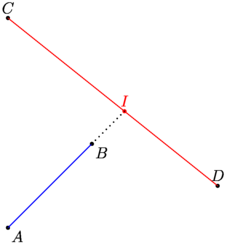
|
size(6cm,0); import math; // Placement de 4 points pair A=(0,0),B=(2,2),C=(0,5),D=(5,1); dot("$A$",A,SE); dot("$B$",B,SE); dot("$C$",C,N); dot("$D$",D,N); // Tracé de [AB] et [CD] draw(A--B,blue); draw(C--D,red); // Construction du point // d'intersection de (AB) et (CD) pair pI=extension(A,B,C,D); dot("$I$",pI,N,red); draw(B--pI,1pt+dotted); |

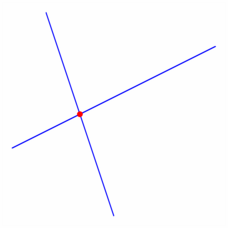
|
size(6cm,0); path segm1=(-1,-1)--(5,2), segm2=(0,3)--(2,-3); draw(segm1^^segm2,blue); dot(intersectionpoint(segm1,segm2),4bp+red); shipout(bbox(3mm,white)); |


|
size(7.5cm,0); // ~~~~~~~~~ DEFINITIONS ~~~~~~~~~ path droite=(-5,5)--(-1,1), cercle=circle((1,0),3); pair pA=intersectionpoint(droite,cercle); // ~~~~~~~~~ CONSTRUCTIONS ~~~~~~~~~ draw(droite,blue); draw(cercle,orange); dot("$A$",pA,2W,4bp+brown); shipout(bbox(3mm,white)); |


|
// Si dans l'exemple précédent la fonction **intersectionpoints** // renvoie un tableau des points d'intersection, // dans cet exemple la fonction **intersectionpoints** (sans 's' !) // renvoie le premier point d'intersection rencontré. size(7.5cm,0); defaultpen(.8bp); path ligne1=(-3,1){dir(45)}..(-1,2)..{dir(10)}(4,0), ligne2=(-3,-1){dir(45)}..(0,3)..(1.5,-1)..{dir(80)}(3,2); draw(ligne1,blue); draw(ligne2,orange); // dot(intersectionpoint(ligne1,ligne2),4bp+brown); dot(intersectionpoint(reverse(ligne1),ligne2),4bp+red); shipout(bbox(3mm,white)); |


|
size(7.5cm,0); // ~~~~~~~~~ DEFINITIONS ~~~~~~~~~ pair p1=(-5,5), p2=(-1,1); path droite=p1--p2, cercle=circle((1,0),3); pair pA=intersectionpoint(droite,cercle), pB=intersectionpoint(p2--interp(p1,p2,2),cercle); // ~~~~~~~~~ CONSTRUCTIONS ~~~~~~~~~ draw(droite,blue); draw(cercle,orange); dot("$A$",pA,2W,4bp+brown); dot("$B$",pB,2SE,4bp+black); draw(p2--pB,dashed+blue); shipout(bbox(3mm,white)); |

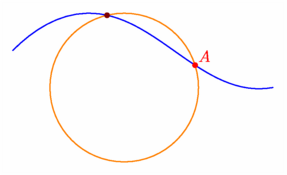
|
size(7.5cm,0); defaultpen(.8bp); // ~~~~~~~~~ DEFINITIONS ~~~~~~~~~ path ligne=(-3,1){dir(45)}..(-1,2)..{dir(10)}(4,0), cercle=scale(2)*unitcircle; pair point1=intersectionpoint(ligne,cercle), point2=intersectionpoint(reverse(ligne),cercle); // ~~~~~~~~~ CONSTRUCTIONS ~~~~~~~~~ draw(ligne,blue); draw(cercle,orange); dot(point1,4bp+brown); dot("$A$",point2,NE,4bp+red); shipout(bbox(3mm,white)); |


|
size(7.5cm,0); defaultpen(.8bp); path ligne1=(-3,1){dir(45)}..(-1,2)..{dir(10)}(4,0), ligne2=(-3,-1){dir(45)}..(0,3)..(1.5,-1)..{dir(80)}(3,2); draw(ligne1,blue); draw(ligne2,orange); // intersectionpoints renvoie un tableau des points d'intersection pair [] tabpts=intersectionpoints(ligne1,ligne2); // le premier point est indicé 0, le deuxième 1, etc... dot(tabpts[0],4bp+brown); dot(tabpts[2],4bp+red); shipout(bbox(3mm,white)); |

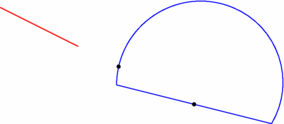
|
size(7.5cm,0); pair pA=(-3,2), pB=(-1,1); path segm=pA--pB, chemin=(0,0)--(4,-1)..(3,2)..cycle; draw(chemin,blue); draw(segm,red); dot(intersectionpoints(pA--interp(pA,pB,3),chemin)); |

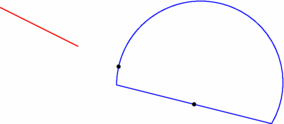
|
size(7.5cm,0); import geometry; pair pA=(-3,2), pB=(-1,1); path segm=pA--pB, chemin=(0,0)--(4,-1)..(3,2)..cycle; draw(chemin,blue); draw(segm,red); dot(intersectionpoints(line(pA,pB),chemin)); |


|
size(7.5cm,0); import geometry; point pA=(-3,2), pB=(-1,1); path chemin=(0,0)--(4,-1)..(3,2)..cycle; draw(chemin,blue); draw(segment(pA,pB),red); dot(intersectionpoints(line(pA,pB),chemin)); |


|
// Intersection d'un "path" avec lui-même. size(7.5cm,0); // ~~~~~~~~~ DEFINITIONS ~~~~~~~~~ path chemin; for (int i=0; i<=7; ++i) chemin=chemin--point(polygon(7),2*i); pair[] p = intersectionpoints(chemin,chemin); // ~~~~~~~~~ CONSTRUCTIONS ~~~~~~~~~ draw(chemin); for (int k=0; k<p.length; ++k) dot(format("%i",k),p[k],red); shipout(bbox(2mm,white)); |


|
// Bizarre... exemple à revoir ! // Intersection d'un "path" avec lui-même. size(7.9cm,0); // ~~~~~~~~~ DEFINITIONS ~~~~~~~~~ path chemin=(-3,0){dir(45)}..(1,2)..{dir(45)}(0,-1) ..(-1,1)..(0,2)..(1,1){dir(-160)}..(-3,2); pair[] p = intersectionpoints(chemin,chemin); pen[] stylo={red,blue}; // ~~~~~~~~~ CONSTRUCTIONS ~~~~~~~~~ draw((0,1)--(0,0)--(1,0),Arrows); dot(chemin,10bp+green); draw(chemin); for (int k=0; k<p.length; ++k) dot(scale(.5)*format("%i",k),p[k],2*dir(k*30),stylo[k%2]); shipout(bbox(1mm,white)); // Bizarre... exemple à revoir ! |

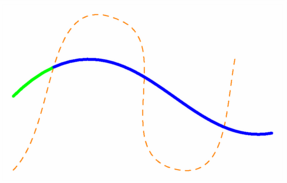
|
/* dans plain_paths.asy, sont définis : le type : struct slice { path before,after; } et les fonctions : slice cut(path p, path knife, int n) slice firstcut(path p, path knife) slice lastcut(path p, path knife) */ size(7.5cm,0); path ligne=(-3,1){dir(45)}..(-1,2)..{dir(10)}(4,0), couteau=(-3,-1){dir(45)}..(0,3)..(1.5,-1)..{dir(80)}(3,2), morceau1=firstcut(ligne,couteau).before, morceau2=firstcut(ligne,couteau).after; // firstcut(ligne,couteau) est de type slice // firstcut(ligne,couteau).before et firstcut(ligne,couteau).after // sont de type path. draw(couteau,dashed+orange); draw(morceau1,2bp+green); draw(morceau2,2bp+blue); shipout(bbox(3mm,white)); |


|
/* dans plain_paths.asy, sont définis : le type : struct slice { path before,after; } et les fonctions : slice cut(path p, path knife, int n) slice firstcut(path p, path knife) slice lastcut(path p, path knife) */ size(7.5cm,0); path ligne=(-3,1){dir(45)}..(-1,2)..{dir(10)}(4,0), couteau=(-3,-1){dir(45)}..(0,3)..(1.5,-1)..{dir(80)}(3,2), morceau1=lastcut(ligne,couteau).before, morceau2=lastcut(ligne,couteau).after; // firstcut(ligne,couteau) est de type slice // firstcut(ligne,couteau).before et firstcut(ligne,couteau).after // sont de type path. draw(couteau,dashed+orange); draw(morceau1,2bp+green); draw(morceau2,2bp+blue); shipout(bbox(3mm,white)); |

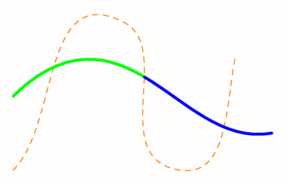
|
/* dans plain_paths.asy, sont définis : le type : struct slice { path before,after; } et les fonctions : slice cut(path p, path knife, int n) slice firstcut(path p, path knife) slice lastcut(path p, path knife) */ size(7.5cm,0); path ligne=(-3,1){dir(45)}..(-1,2)..{dir(10)}(4,0), couteau=(-3,-1){dir(45)}..(0,3)..(1.5,-1)..{dir(80)}(3,2), morceau1=cut(ligne,couteau,1).before, morceau2=cut(ligne,couteau,1).after; // cut(ligne,couteau,n) est de type slice // cut(ligne,couteau,n).before et cut(ligne,couteau,n).after // sont de type path. draw(couteau,dashed+orange); draw(morceau1,2bp+green); draw(morceau2,2bp+blue); shipout(bbox(3mm,white)); |

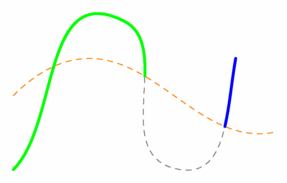
|
// Et si on inverve ligne-couteau et ligne coupée... size(7.5cm,0); path couteau=(-3,1){dir(45)}..(-1,2)..{dir(10)}(4,0), ligne=(-3,-1){dir(45)}..(0,3)..(1.5,-1)..{dir(80)}(3,2), morceau1=cut(ligne,couteau,1).before, morceau2=cut(ligne,couteau,2).after; // cut(ligne,couteau,n) est de type slice // cut(ligne,couteau,n).before et cut(ligne,couteau,n).after // sont de type path. draw(couteau,dashed+orange); draw(ligne,dashed+gray); draw(morceau1,2bp+green); draw(morceau2,2bp+blue); shipout(bbox(3mm,white)); |

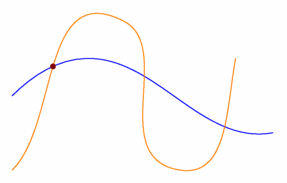
|
/* real[] intersect(path p, path q, real fuzz=0); If p and q have at least one intersection point, return a real array of length 2 containing the times representing the respective path times along p and q, in the sense of point(path, real), for one such intersection point (as chosen by the algorithm described on page 137 of The MetaFontbook). The computations are performed to the absolute error specified by fuzz, or, if fuzz is 0, to machine precision. If the paths do not intersect, return a real array of length Cf. exemple suivant pour l'utilisation de real[][] intersections(path p, path q, real fuzz=0); */ size(7.5cm,0); path ligne1=(-3,1){dir(45)}..(-1,2)..{dir(10)}(4,0), ligne2=(-3,-1){dir(45)}..(0,3)..(1.5,-1)..{dir(80)}(3,2); real[] parametres=intersect(ligne1,ligne2); pair pA=point(ligne1,parametres[0]); draw(ligne1,blue); draw(ligne2,orange); // dot(pA,4bp+brown); shipout(bbox(3mm,white)); |


|
/* real[][] intersections(path p, path q, real fuzz=0); Return all intersection times of paths p and q as a sorted array of real arrays of length 2 (see [sort], page 67). The computations are performed to the absolute error specified by fuzz, or, if fuzz is 0, to machine precision. Cf. exemple précédent pour l'utilisation de real[] intersect(path p, path q, real fuzz=0); */ size(7.5cm,0); path ligne1=(-3,1){dir(45)}..(-1,2)..{dir(10)}(4,0), ligne2=(-3,-1){dir(45)}..(0,3)..(1.5,-1)..{dir(80)}(3,2); real[][] parametres=intersections(ligne1,ligne2); pair pA=point(ligne1,parametres[0][0]), pB=point(ligne1,parametres[1][0]), pC=point(ligne2,parametres[2][1]); draw(ligne1,blue); draw(ligne2,orange); // dot(pA,4bp+brown); dot(pB,4bp+green); dot(pC,4bp+purple); shipout(bbox(3mm,white)); |


|
// La fonction times(path p, real x=a) bien pratique pour connaitre le // "time" des points d'intersection de p avec la droite d'équation x=a. import geometry; size(8cm,0); // Pour matérialiser le repère : draw((1,0)--(0,0)--(0,1),Arrows()); // Tracé d'un chemin(path) p et placement des points le définissant. path p=(-.5,0)..(2,0)..(2,1)..(0,2)..(-1.5,1)..(-0.5,1.5)..cycle; draw("p",p); dot(p,2bp+black); for(int k; k<length(p); ++k) label(string(k),point(p,k),unit(accel(p,k))); real a=-1, b=-.5, c=2; real[] ta=times(p,a), tb=times(p,b), tc=times(p,c); for(int k=0; k<ta.length; ++k) dot(point(p,ta[k]),3bp+red); for(int k=0; k<tb.length; ++k) dot(point(p,tb[k]),3bp+blue); for(int k=0; k<tc.length; ++k) dot(point(p,tc[k]),3bp+green); draw(Label(format("$x=%f$",a),BeginPoint,S),line(1,0,-a),dashed+red); draw(Label(format("$x=%f$",b),EndPoint,N),line(1,0,-b),dashed+blue); draw(Label(format("$x=%f$",c),BeginPoint,S),line(1,0,-c),dashed+green); addMargins(0,1cm); |

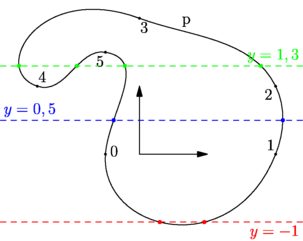
|
// La fonction times(path p, pair z) bien pratique pour connaitre le // "time" des points d'intersection de p avec la droite horizontale // passant par le point z. import geometry; size(8cm,0); // Pour matérialiser le repère : draw((1,0)--(0,0)--(0,1),Arrows()); // Tracé d'un chemin(path) p et placement des points le définissant. path p=(-.5,0)..(2,0)..(2,1)..(0,2)..(-1.5,1)..(-0.5,1.5)..cycle; draw("p",p); dot(p,2bp+black); for(int k; k<length(p); ++k) label(string(k),point(p,k),unit(accel(p,k))); pair pA=(0,-1), pB=(0,0.5), pC=(0,1.3); real[] ta=times(p,pA), tb=times(p,pB), tc=times(p,pC); for(int k=0; k<ta.length; ++k) dot(point(p,ta[k]),3bp+red); for(int k=0; k<tb.length; ++k) dot(point(p,tb[k]),3bp+blue); for(int k=0; k<tc.length; ++k) dot(point(p,tc[k]),3bp+green); draw(Label(format("$y=%f$",pA.y),BeginPoint,SW),line(0,1,-pA.y),dashed+red); draw(Label(format("$y=%f$",pB.y),EndPoint,NE),line(0,1,-pB.y),dashed+blue); draw(Label(format("$y=%f$",pC.y),BeginPoint,NW),line(0,1,-pC.y),dashed+green); addMargins(.5cm,.2cm); |
Dernière modification le Fri Oct 28 12:59:22 CEST 2011 par G.Marris Valide XHTML